Japan Self-Defense Forces ordered the development of a new coastal missile system
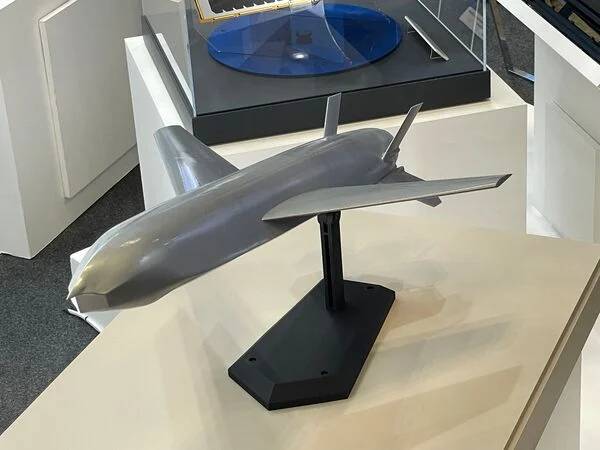
Layout of a promising anti-ship missile from KHI, shown at DSEI Japan 2023. Photo by Jane's
The Japan Self-Defense Forces issued an official contract to the industry for the development of a promising coastal missile system with an anti-ship missile. With its help, in the distant future, they plan to replace existing equipment that is not new. A new type of DBK will be used to protect the country's maritime borders, as well as to project force in disputed areas.
The need for an update
At the end of the eighties, the new Type 88 DBK with the SSM-1 guided missile entered service with the Japan Ground Self-Defense Forces. More than 50 launchers capable of carrying six missiles each, as well as radar stations, command posts, etc. were purchased for the troops. At the end of the 12s, the existing DBK underwent a deep modernization, as a result of which the Self-Defense Forces received the Type XNUMX complex with a new missile.
With all its advantages, the available complexes "Type 88" and "Type 12" are not without drawbacks. Affects the great age of equipment and weapons, as well as progress in shipbuilding and air defense systems. As a result, the Self-Defense Forces require a completely new BRK that meets modern requirements and has the appropriate characteristics.
Not so long ago it became known that the Japanese military department and industry are already working on the issue of replacing the existing DBK and are preparing a new project. As reported, the Self-Defense Forces and Kawasaki Heavy Industries (KHI) have been studying topical issues for several years and are engaged in shaping the image of the future complex and its rocket.
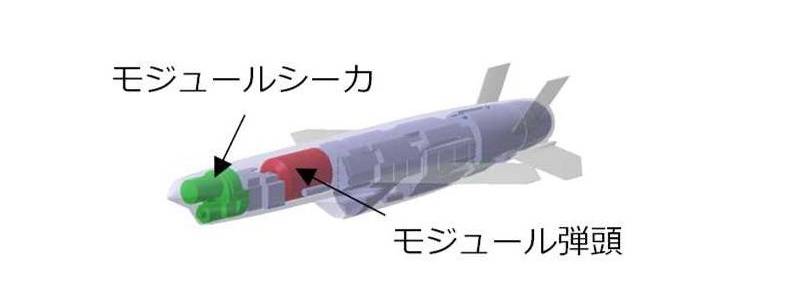
Scheme of a promising rocket. Modular seeker (green) and warhead (red) are shown. Graphics of the Ministry of Defense of Japan
Developments on this topic were first presented in March 2023 at the DSEI Japan exhibition. KHI showed a mock-up of a promising multi-purpose cruise missile with improved performance characteristics. It can be used against ground and surface targets at ranges of at least 1000 km.
It is already provided for use with different platforms. In the presented form, the missile can be used by surface ships, aircraft and ground systems. If there is interest from the customer, it is possible to develop modifications for submarines.
During DSEI Japan 2023, the developer company did not specify some details of the project and plans for the future, both its own and the customer's. In particular, they did not say whether the military department is interested in the further development of the project, and how long it will take to develop it if there is an order.
Development contract
On June 6, the Japanese Ministry of Defense published a press release on the signing of four contracts at once for the development of missile systems and related technologies. The Self-Defense Forces want to get new ABRs and ammunition of different classes for them. In particular, the development of a complex with a cruise missile is being launched. The corresponding order was received by KHI on June 2.
According to the disclosed information, work on a promising winged anti-ship missile will begin in the very near future and will last for several years. The new DBK is planned to be put into service in 2027. Approx. 315 billion yen (approx. US$2,3 billion).
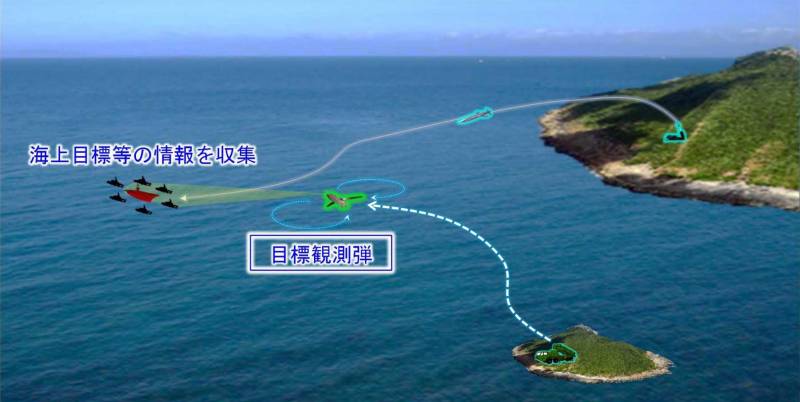
The use of a new rocket. In the middle part of the trajectory, the missile barrages and searches for targets. Graphics of the Ministry of Defense of Japan
The press release schematically shows the use of advanced missile weapons against enemy ships in order to protect the island territories. In addition, a diagram of a new cruise missile is given. It shows the exterior of the product, as well as the composition and layout of the units. The drawn RCC is similar to the layout from the March exhibition, which allows us to draw clear conclusions.
Estimated appearance
Information from the DSEI Japan exhibition and the latest information from the Japanese military department allow us to understand how they see the new anti-ship missile and the complex as a whole. In addition, the proposed architecture of the future coastal defense system, built on newly developed complexes, was also disclosed. It is likely that in the future, as development progresses, the KHI missile and its DBK will change, but a radical overhaul is unlikely.
The new Japanese anti-ship missiles are built according to the traditional “projectile-aircraft” scheme of a normal aerodynamic scheme. The fuselage has a large elongation and receives a pointed nose, in which the means of searching for targets are placed. A mid-range swept wing is provided; for placement in a transport and launch container or under an aircraft, it will be collapsible. In the tail there is a plumage of four planes - two vertical keels and a pair of stabilizers with a negative transverse “V”.
The missile's own length will reach or exceed 6 m. The possibility of increasing this parameter to 10 m is also mentioned. Due to what such a spread in dimensions is obtained, it is not clear. Perhaps KHI had in mind the installation of a starting engine for takeoff from the ground / water and the subsequent acceleration. They may also plan to develop a larger modification of the product with improved performance.
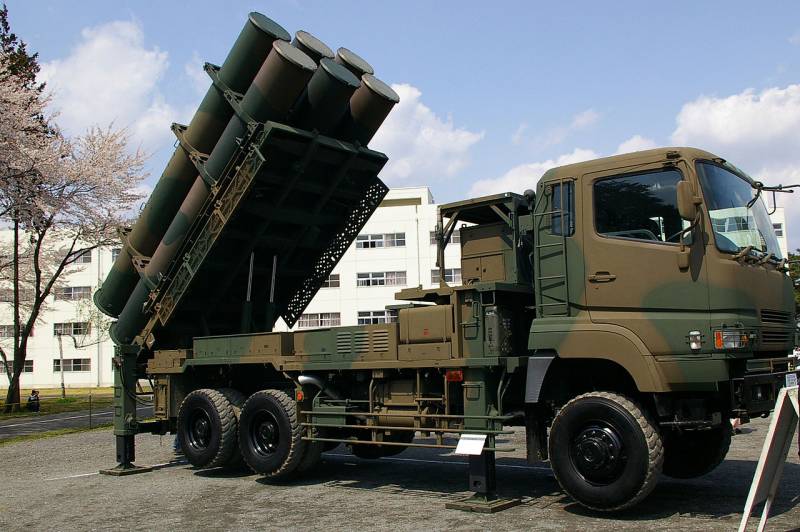
Launcher DBK "Type 88" in firing position. Photo by Wikimedia Commons
The rocket will receive a mid-flight turbojet engine located in the tail of the fuselage. The model and characteristics are not named. With its help, flight will be carried out at speeds of the order of 0,8M. Flight range - at least 1000 km. Probably, they will provide different modes and flight profiles that allow you to bypass enemy defenses.
A combined control system of modular architecture is being developed for the rocket. On the main part of the trajectory, the autopilot will use inertial and satellite navigation. In the intended target area, an infrared and / or active radar homing head will be turned on. Due to the GOS, the product will be able to search for a target and aim at it. If necessary, anti-ship missiles will be able to barrage in a given area, waiting for the target to appear.
Open publications mention the use of a modular warhead. Inside the fuselage, behind the GOS, a volume is provided for installing charges of various types. Probably, the main combat load will be a high-explosive fragmentation warhead, incl. penetrating action.
The appearance of the coastal missile system for promising ammunition has not yet been disclosed. A recent press release from the Japanese Ministry of Defense provides only schematic images. On them, anti-ship missiles are launched from ground-based installations on a wheelbase with a swinging TPK package - in fact, photographs of the Type 88 or Type 12 DBK were used. Means of detecting surface targets and target designation are not shown at all in the diagrams.
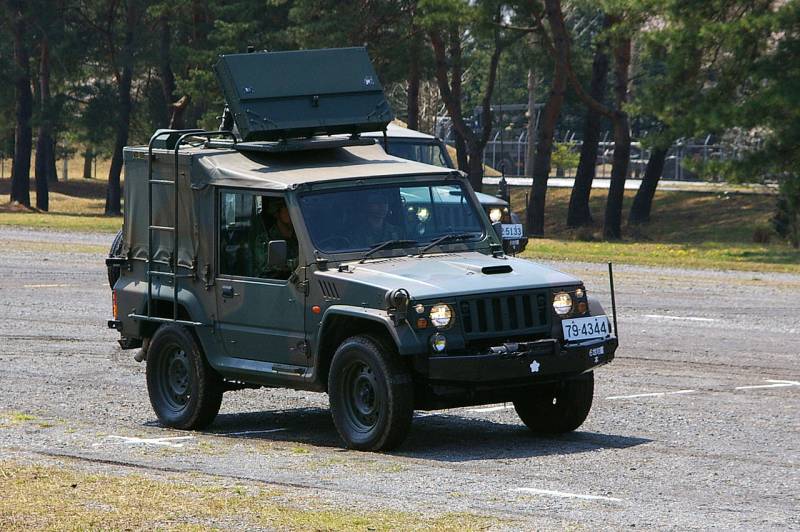
Radar complex "Type 88". Photo by Wikimedia Commons
Probably, from the point of view of the composition of ground facilities, the new DBK will not differ from the existing ones. The missile or missiles in the TPK will be placed on a self-propelled launcher built on the basis of a truck. Such a chassis will give the complex the necessary mobility and allow you to get the maximum possible ammunition load.
The complex will most likely include its own mobile radar station. She will search for surface targets in the coastal zone. To detect ships beyond the radio horizon, third-party means will have to be used on surface or air platforms. To process data from radars and from third-party sources, as well as to control launchers, a full-time command post is required, also on a self-propelled base.
Judging by recent contracts, the KHI cruise anti-ship missile will be used in one defense system along with other weapons. In particular, it is planned to develop a supersonic anti-ship missile with a high-altitude flight path. Also in the past, the interest of the Japanese Self-Defense Forces in hypersonic technologies was mentioned.
Weapons of the future
Thus, the Japanese military department conceived a major coastal defense renewal program. The main measure in this context for the coming years will be the development of advanced missile systems with enhanced performance. In particular, a coastal complex with a subsonic cruise missile will be created. In addition, it is proposed to make the rocket universal and use it with different carriers.
To date, the DBK project from Kawasaki Heavy Industries has passed the early stages. The shape of the rocket has been formed, and now it is allowed to be shown at public events. Over the next few years, design will be completed, tests will be carried out and the complex will go into service. Whether it will be possible to fulfill all the requirements of the customer and meet the deadlines, it will become clear in 2027 or later.
Information